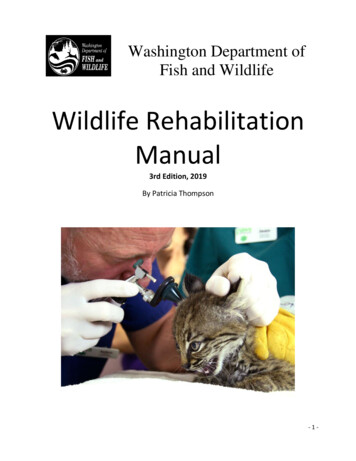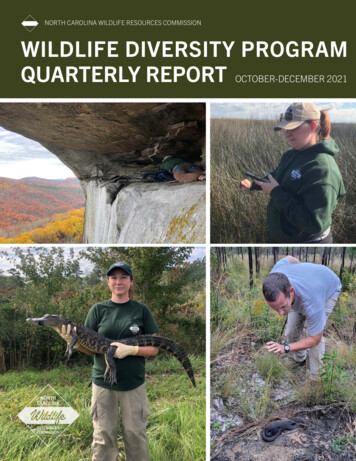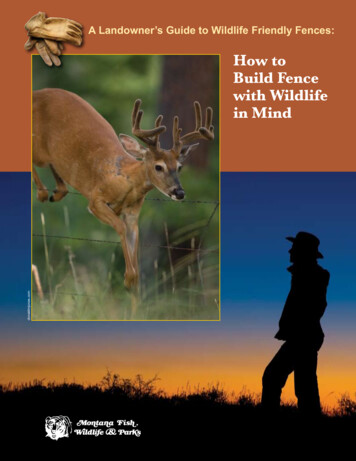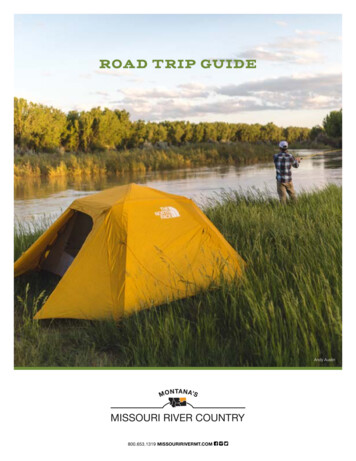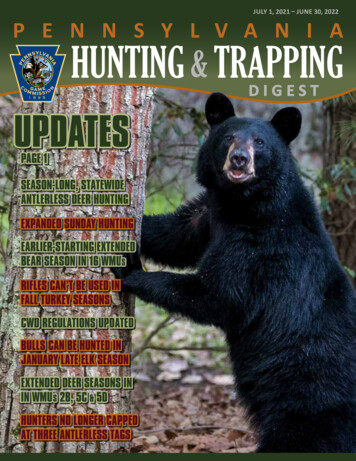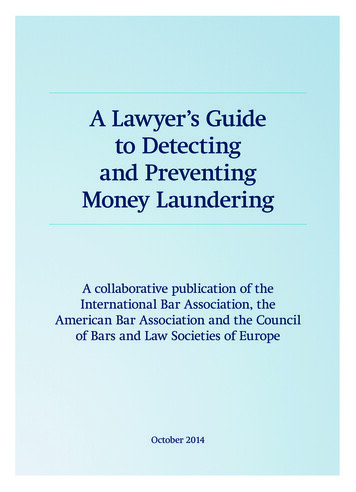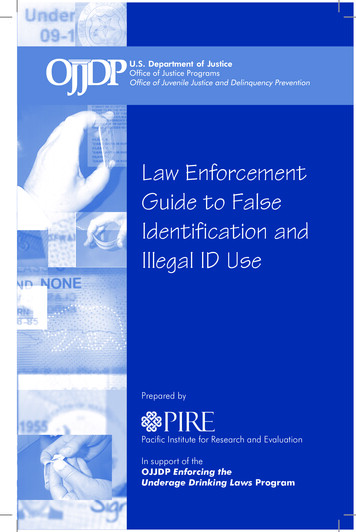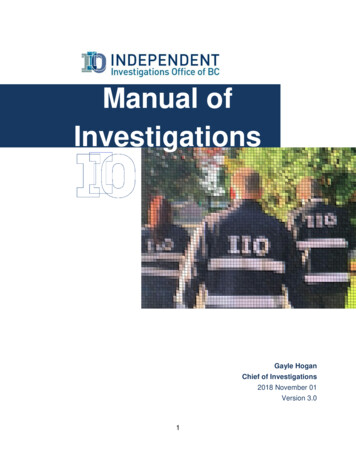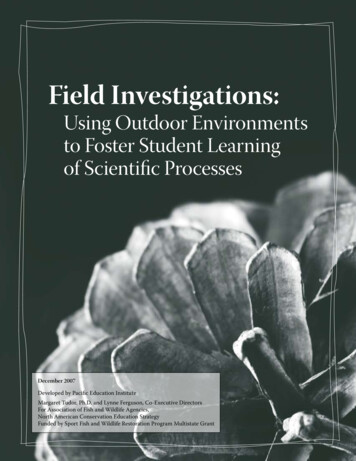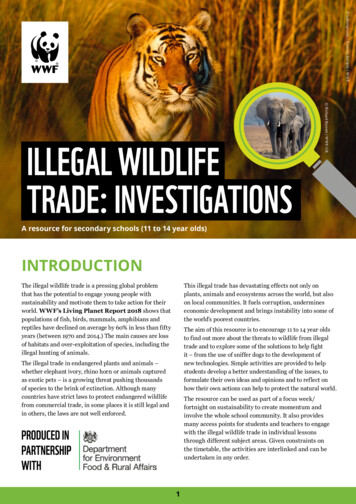
Transcription
naturepl.com / Francois Savigny / WWF Richard Barrett / WWF-UKILLEGAL WILDLIFETRADE: INVESTIGATIONSA resource for secondary schools (11 to 14 year olds)INTRODUCTIONThis illegal trade has devastating effects not only onplants, animals and ecosystems across the world, but alsoon local communities. It fuels corruption, undermineseconomic development and brings instability into some ofthe world’s poorest countries.The illegal wildlife trade is a pressing global problemthat has the potential to engage young people withsustainability and motivate them to take action for theirworld. WWF’s Living Planet Report 2018 shows thatpopulations of fish, birds, mammals, amphibians andreptiles have declined on average by 60% in less than fiftyyears (between 1970 and 2014.) The main causes are lossof habitats and over-exploitation of species, including theillegal hunting of animals.The aim of this resource is to encourage 11 to 14 year oldsto find out more about the threats to wildlife from illegaltrade and to explore some of the solutions to help fightit – from the use of sniffer dogs to the development ofnew technologies. Simple activities are provided to helpstudents develop a better understanding of the issues, toformulate their own ideas and opinions and to reflect onhow their own actions can help to protect the natural world.The illegal trade in endangered plants and animals –whether elephant ivory, rhino horn or animals capturedas exotic pets – is a growing threat pushing thousandsof species to the brink of extinction. Although manycountries have strict laws to protect endangered wildlifefrom commercial trade, in some places it is still legal andin others, the laws are not well enforced.The resource can be used as part of a focus week/fortnight on sustainability to create momentum andinvolve the whole school community. It also providesmany access points for students and teachers to engagewith the illegal wildlife trade in individual lessonsthrough different subject areas. Given constraints onthe timetable, the activities are interlinked and can beundertaken in any order.1
Wil Luiijf / WWFWhat is the illegalwildlife trade?Illegal wildlife trade means the selling or exchange ofwild plants and animals that are at risk and protected bylaw. It involves live plants and animals (e.g. rare orchidsor tropical birds) or products derived from them(e.g. jewellery, medicine, food or clothing).On average,more than 100,000pangolins, 20,000elephants, 1,000rhinos and 100 tigersare killed each yeardue to the illegalwildlife trade.Share of type of wildlife among total seizures 2005 – 2014.2%2%1%1%2%RosewoodElephant11%Assorted ine turtle3%ParrotsBig cats5%RaptorsTortoise and freshwater turtle6%Coral9%18%SturgeonOthersSource: UNDOC. 2016 World wildlife crime report. Trafficking in protected species.See: wildlife/World Wildlife Crime Report 2016 final.pdf2
Greg Armfield / WWF-UK WWF / James MorganActivitiesWhat is the illegal wildlife trade?An interactive quiz to explore whysome plant and animal species are atrisk from the illegal wildlife trade andwhere the hotspots are acrossthe world.Holiday souvenirsTaking on the role of officials tacklingthe illegal trade in wildlife, studentsinspect a range of holiday souvenirsand produce a leaflet or an article toraise awareness of the negative impactof buying wildlife products.What’s the problem?An activity using photos to encouragestudents to raise questions andexplore the connections betweenthe environmental, social, politicaland economic aspects of the illegaltrafficking of wildlife.Make your voice countStudents create powerful infographicsor posters to promote awareness inthe school community of the negativeimpact of the illegal wildlife trade.Breaking the chainThrough a debate, students find outwho is involved in the illegal wildlifetrade and explore possible solutionsto help break the chain.Take action for your worldUse of persuasive skills to createa campaign and inspire the wholeschool community to take actionto help protect biodiversity, locallyand globally.3
Edward Parker / WWF Brent Stirton / Getty Images / WWF-UK naturepl.com /Roland Seitre / WWFWhat is the illegalwildlife trade?Subject areasBiology/GeographyWhat to doOverviewThrough an interactive quiz based on facts,photos and short films, students explore whatillegal wildlife trade means and why it poses aserious threat to many endangered plant andanimal species across the world. Divide the class into teams and give each team acopy of the quiz. Run though the questions on thePowerPoint, giving them time to answer on theirquiz sheet. Then go through the questions with the class to checktheir answers (see answer sheet below). Using the world map, hold a class discussion onhow illegal trade is decimating wildlife across theworld. What does trade mean? Why do people tradeendangered animals and plants? Which species aremost threatened? Where are the hotspots for wildlifetrade? Bring the focus back to the students. Howis the illegal wildlife trade relevant to them? (Forexample, whether it happens in our own country, theimportance of maintaining biodiversity for wildlife andfor people, how this trade funds organised crime.) Back in their teams, encourage students to considerhow the illegal wildlife trade affects biodiversity andwhy this is a problem – see questions to promptdiscussion below. Students write down their ideas,with periodic peer-sharing for support. Using the resource sheet ‘Wildlife at risk’, they thenresearch one of the animals or plants on the map andcreate a profile for this species as a PowerPoint slideor factsheet. These can be displayed around the schoolto raise awareness and get people talking about illegalwildlife trade.Objectives To learn what illegal wildlife trade means and whysome species are at risk of extinction To explore where wildlife is illegally taken for trade To understand the impact of illegal wildlife trade onbiodiversityWhat you need ‘Illegal wildlife trade’ world map ‘What is the illegal wildlife trade?’ quiz andanswers Resource sheet: ‘Illegal wildlife trade quiz’(one per team) Resource sheet: ‘Illegal wildlife trade quiz answers’ Resource sheet: ‘Wildlife at risk’4
WWF / Carlos DrewsThe impact of the illegal wildlife trade on biodiversityQuestions to prompt discussion:How does the illegal wildlife trade affect biodiversity inthe places where wild plants and animals end up?How does the illegal wildlife trade affect biodiversity in theplaces from which the wild plants and animals are taken? If living organisms are released into the wild intheir destination countries, how might this affectHow does poaching affect the numbers of the targetbiodiversity? (Animals that are illegally traded may bespecies? (reduced numbers and possible extinction)sold as pets. If these become unwanted they may beHow might the illegal wildlife trade affectreleased into an existing ecosystem and haveecosystems? (taking away or killinga negative impact on biodiversity. Invasiveanimals that have important roles inspecies can compete with native speciestheir ecosystems – e.g. elephantsBiodiversity:for resources, predate on them orspreading seeds in their dung orthe variety ofspread diseases that were not presentdigging water for other animals.)in the environment.)living things onEarth and withinan ecosystem.Stopping the illegalwildlife trade5
Resource sheet: Illegal wildlife trade quiz1.Watch the film and name five animals affected byillegal trade. Adam Oswell / WWF3.This animal isthe most heavilytrafficked wildmammal in theworld. Can youguess what it Watch the film and listen for numbers tohelp you answer the following questions.7.How many rhinos are poached on average each year?Around 150Around 600Around 1,000Around 5,400How many animal species have been found to be inillegal wildlife trade across the world?Around 25Around 700Around 2,400Around 7,000 naturepl.com / Roland Seitre / WWF5.45%The illegal wildlife trade doesn’t affect wild plants. Itonly affects animals.True4.What percentage of tigers have been lost in thelast century? Brent Stirton / Getty Images / WWF-UK Photoshot License Ltd / Alamy Stock Photo2.How many Africanelephants are killedby poachers onaverage every day?183555 Martin Harvey / WWF108. How many pangolins have been snatched and killedin the last decade?6Around 1,500Around 5,400Around 225,000Around 1 million
Resource sheet: Illegal wildlife trade quiz9.13. Which of these animals is captured to maketraditional medicine?What is the illegal wildlife trade estimated to beworth a year?Around 15 billionAround 55 billionContinue to answer the questions basedon what you know.PandaBird of paradiseMusk deer12. How many tigers areleft in the wild?Skunk15. All wildlife trade is illegal.TrueAround 500Around 3,900Around 9,500Around 40,000 naturepl.com / Francois Savigny / WWF7 Anthony B. Rath / WWFPythonFalse Grigori Mazmanyants / WWFTrue14. Which animal is captured for its scent gland to makeperfume and traditional medicine? Martin Harvey / WWF11. More African elephants are being killed than arebeing born.Tiger Adobe StockLocal craft WWF-Malaysia / Mazidi Abd Ghani Martin Harvey / WWFExotic pet Ola Jennersten / WWF-Sweden James Morgan / WWF-USTiger skinGiraffe Adam Oswell / WWFIvory jewelleryStraw basketsToucan Martin Harvey / WWF WWF / James Morgan10. Which product isillegal to buy as aholiday souvenir?You can tick morethan one product. R.Isotti, A.Cambone / Homo Ambiens / WWFAround 150 million naturepl.com / Andy Rouse / WWFAround 55 millionFalse
Resource sheet: Illegal wildlife trade quiz answers8. How many pangolins have been snatched and killedin the last decade?1. Watch the film and name five animals affected byillegal trade.ANSWER: Around 1 millionPOSSIBLE ANSWERS: Elephant, tiger, rhino,jaguar, snow leopard, pangolin, marine turtle,macaw, orangutan, shark9. What is the illegal wildlife trade estimated to beworth a year?2. This animal is the most heavily trafficked wildmammal in the world. Can you guess what it is?ANSWER: Around 15 billionANSWER: PangolinFACT: On average one pangolin is snatched fromthe wild every five minutes. Pangolins are traffickedprimarily to China and Vietnam where their meatis considered a delicacy and their scales are used intraditional medicine.10. Which product is illegal to buy as a holiday souvenir?You can tick more than one product.ANSWERS: Ivory jewellery, tiger skin,exotic pet11. More African elephants are being killed than arebeing born.3. The illegal wildlife trade doesn’t affect wild plants. Itonly affects animals.ANSWER: TrueANSWER: FalseFACT: About 40% of wildlife seized from illegal tradebetween 2005 and 2014 was timber (rosewood andagarwood).12. How many tigers are left in the wild?ANSWER: Around 3,90013. Which of these animals is captured to maketraditional medicine?4. How many animal species have been found to be inillegal wildlife trade across the world?ANSWER: TigerFACT: Tigers are killed for their skins, and for theirbones which are used in traditional medicine.ANSWER: Around 7,0005. How many African elephants are killed by poacherson average every day?14. Which animal is captured for its scent gland to makeperfume and traditional medicine?ANSWER: 55FACT: Around 20,000 African elephants are beingkilled every year for their ivory – that’s around55 every day!ANSWER: Musk deerFACT: Musk is one of the most valuable naturalproducts in the animal kingdom and can be worththree times more than its weight in gold.6. What percentage of tigers have been lost in thelast century?15. All wildlife trade is illegal.ANSWER: 95%FACT: This is due to the illegal wildlife trade and lossof habitats.ANSWER: FalseFACT: Wild plants and animals from thousands ofspecies are caught or harvested from the wild to besold legally as food, pets, ornamental plants, leatherand medicine. Wildlife trade becomes a problemwhen it threatens the survival of species in the wild.7. How many rhinos are poached on average each year?ANSWER: Around 1,000FACT: On average, 3 rhinos are poached each day.8
Resource sheet: Wildlife at riskResearch one animal or plant threatened by the illegal wildlife trade and create a factsheet for your species.Name of your plant or animalWhere are these found in the world?Why are they traded illegally? naturepl.com /ah /A nup ShW WFre:should cadasons wein woo deresengrerihTcleato grows createnttshaanplep Elnewich allowrish.areas, whies to flouecsprhe.dsean d otsetansperse plcare They disibility toonspreve ahaeW e.for w ildlifWhen yo u haveco mplete d yo urfactsheet yo uco uld createa poster or asli de.Three reasons why we should care:9
Photoshot License Ltd / Alamy Stock PhotoWhat’s the problem?Subject area Students can peer-share ideas, leading into abroader class discussion. Encourage them to makeconnections between the environmental, social,political and economic aspects of the illegal trade inwildlife. Why do people trade wildlife (e.g. money,use in traditional medicine, food as a delicacy, exoticpets etc.)? Why is the wildlife trade a problem forplants, animals and ecosystems? What role doesculture play in supporting wildlife trade (e.g. demandfor ivory ornaments and jewellery in Asia)? Whatrole does economy play? How do our choices asconsumers affect wild animals and plants? The questions and ideas generated by the studentsmight be an interesting starting point for furtherenquiry on wildlife and conservation.GeographyOverviewThrough the use of photographs, studentsare encouraged to raise questions and makeconnections between the environmental, social,political and economic aspects of the illegalwildlife trade.Objectives To develop an understanding of why there is an illegaltrade in wildlife and how it impacts on animals, peopleand the environment To develop critical thinking and enquiry skills throughthe use of photographsWhat you need Resource sheet: ‘Illegal wildlife trade photo bank’ Resource sheet: ‘Development compass rose’Where are elephants found inthe world?What do elephants need tosurvive? What do they eat?Why are elephants hunted fortheir tusks?Why do people want to buythings made from ivory?Who makes decisions to helpprotect elephants?How can we stop people frombuying ivory products?How can elephants be dangerousto people?Why do people kill elephants?What to do The development compass rose is a useful tool to helpstudents identify the issues, ask questions about theworld around them and make connections. Workingin pairs, students select an image from the resourcesheet ‘Illegal wildlife trade photo bank’ (e.g. herd ofelephants, ivory objects, a ranger at work, sniffer dog,ship and containers, and pangolin). Using the resourcesheet ‘Development compass rose’, they identifyrelevant questions about the image for each point ofthe compass. How might the questions from differentpoints connect with each other?10
Resource sheet: Illegal wildlife trade photo bank Martin Harvey / WWF Jamie Cotten / IFAW / WWF-US11
Resource sheet: Illegal wildlife trade photo bank Greg Armfield / WWF-UK Juozas Cernius / WWF-UK12
Resource sheet: Illegal wildlife trade photo bank Adobe Stock Photoshot License Ltd / Alamy Stock Photo13
Resource sheet: Development compass roseQuestions about energy, air,water, soil, living things andtheir environmentQuestions about money,buying and selling, jobs andproducing thingsQuestions about who makesdecisions, what choices there are,who benefits and who loses outQuestions about people, theirrelationships, culture, traditionsand the way they liveAdapted from Tide global learning14
WWF / James MorganThe Convention on International Trade inEndangered Species of Wild Fauna and Flora (CITES)is an international agreement between governmentswhich was set up to ensure that international tradein wild animals and plants does not threaten theirsurvival. CITES controls the trade of about 35,000plant and animal species, which are grouped intothree lists (titled Appendices I, II, and III) dependingon how much protection they need. The first listincludes the most highly endangered animals andplants. Trade in these species or their parts is bannedexcept in rare situations. Membership of CITESis voluntary – 183 countries out of more than 190worldwide are currently signatories. All membercountries must pass laws to make sure the CITESrules are followed within their national boundaries.Breakingthe chain(Source: CITES)Subject areafarms? to produce single-use plastic items? to runa website where people download music/videos forfree without the artist’s permission?). Each studentwrites a brief answer on a Post-it note – right/wrongand why – and sticks it on the board.Spoken languageOverviewThrough a debate, students find out moreabout who is involved in the illegal wildlifetrade and research different solutions to helpbreak the chain, from the use of sniffer dogsto the development of new technologies.Objectives To learn more about the factors that drive theillegal wildlife trade and who is involved To think critically about the illegal wildlife tradefrom different perspectives and explore solutions To develop language and presentation skillsWhat you need Post-it notes (one per student) Resource sheet: ‘Who’s responsible?’ Resource sheet: ‘How to break the chain’What to do Start by exploring an everyday ethical dilemma tohelp students understand the concept of supplyand demand and explore different viewpoints (e.g.Is it right or wrong that professional footballersearn so much money? to keep chickens in battery15 Share and discuss their answers. Is the overall viewthat it is right or wrong? If so, who’s responsible(e.g. footballers, farmers, manufacturers, sellers,consumers)? Link this critical thinking back to theillegal wildlife trade. Is it right to take plants andanimals illegally from the wild for trade and why? In pairs or small groups, ask students to discuss thequestions on the resource sheet ‘Who’s responsible?’.Encourage them to see that all parts of this chain areinterdependent, from poachers, to smugglers, dealersand consumers – without any one link, the wholechain would break. Ask students to imagine they have been invited toparticipate in a global conference on illegal wildlifetrade. Their government has committed additionalfunding to fight the illegal trade and is invitingproposals. Each team selects or is given one solutionfrom the resource sheet ‘How to break the chain’.They prepare their arguments and choose who theywant to represent in the debate (e.g. environmentalNGO, ranger, scientist or business leader). Onerepresentative from each team presents a pitch (upto 2 minutes) to persuade others, followed by a classdebate. Which two options should be supported aspriorities to help break the trade chain? Students voteon their preferred two ideas.
Resource sheet: ‘Who’s responsible?’1. What is happening in these images?2. Who is involved in the illegal wildlife trade?3. Why do people buy illegal wildlife products?4. How is the illegal wildlife trade relevant to us?5. Can you think of any possible solutions that wouldhelp break the chain?16
Resource sheet: ‘How to break the chain’Increase the number of wildliferangers and give them moretraining and resources (e.g.clothing, all-terrain vehicles,camera traps, night-vision goggles)Stop the demand!Encourage people to stopbuying wildlife products fromthreatened speciesUse of technology and science todetect poachers and traffickingof wildlife products (e.g. DNAtracking, thermal sensors,satellite images, drones)Create more national parks toprotect wildlifeTackle illegal wildlife trade onthe webEncourage people to usealternatives to wildlife productssuch as traditional medicinecontaining animal parts or bagsmade from animal skin.Work with shops and smallbusinesses to stop selling illegallysourced live wild animals andproducts made from animal partsUndercover investigation toidentify the routes used by wildlifesmugglers17
WWF / James MorganHoliday souvenirsSubject areasWhat to doEnglish/ Design & technologyOverviewTaking on the role of officials tackling theillegal wildlife trade, students inspect a range ofholiday souvenirs and produce a tourist leafletor an article to raise awareness of the negativeimpact of buying wildlife products. Using the WWF short film, introduce the importantrole of sniffer dogs in detecting wildlife products suchas ivory and rhino horn. Invite students to take on the role of officials tacklingthe illegal wildlife trade and inspect a range ofholiday souvenirs shown on photocards on theresource sheet ‘Holiday souvenirs’. Which productsshould they avoid buying and why? (see ‘Holidaysouvenirs answer sheet’). Hold a class discussion around these objects.What would happen if the demand for theseproducts stopped? How can our choices asconsumers affect wildlife? In pairs, students can produce a tourist leaflet oran article for an in-flight magazine, travel agentor the travel section of a newspaper to informtravellers why they should avoid buying illegalwildlife products. Other ideas might be to design acomplimentary bookmark for air passengers or alogo to certify that products are not connected withthe illegal wildlife trade.Objectives To learn more about why animals are capturedfor trade To raise awareness of how our choices asconsumers can have a negative impact on wildlifeand the environment To explore ways to tackle the illegal wildlife tradeWhat you need WWF film ‘Sniffer dogs’ Resource sheet: ‘Holiday souvenirs’ ‘Holiday souvenirs answer sheet’ Each student could analysethe work of two or three of theirclassmates, suggesting how eachwork might dissuade people frompurchasing wildlife productswhile on holiday. Michel Gunther / WWF WWF / James Morgan18
Resource sheet: Holiday souvenirs NACSO/WWF in Namibia Michel Gunther / WWFTraditional medicine containing tiger bones and rhino hornLocal pottery David Lawson / WWF-UK WWF-Malaysia / Mazidi Abd GhaniBraceletClothing made from reptile skin iStock Adobe StockWoollen jumperRare wild orchid James Morgan / WWF-US naturepl.com / Vivek Menon / WWFShawl made from the fur of the endangeredTibetan antelopeStraw basket19
Resource sheet: Holiday souvenirs Michel Gunther / WWF WWF / Folke WulfIvory ornamentCoral jewellery Ola Jennersten / WWF-Sweden Kevin Schafer / WWFLive reptileBag made from recycled plastic iStock Adobe StockTortoiseshell jewelleryMusical instrument made from sustainable wood Edward Parker / WWF Brent Stirton / Getty ImagesGiraffe carved from sustainable woodTiger skin20
Holiday souvenirs answer sheet21
Edward Parker / WWF WWF / James MorganMake yourvoice countSubject areasMaths/Design & technologyOverviewUsing facts, numbers and graphs, studentscreate powerful infographics or posters to raiseawareness of the impact of illegal trade onwildlife, ecosystems and people.ObjectivesWhat to do To communicate key issues about the illegal wildlifetrade in numbers To explore creative and engaging ways ofcommunicating data To convey their views and message through avisual mediumIntroduce the graph ‘Reverse the decline inbiodiversity’ (WWF PowerPoint, slide 1) and discussthe three possible scenarios – further decline ofanimal populations, false alarm (It will stay the same)and nature recovering due to global change. How canwe raise awareness to help conserve biodiversity? Then show the infographic example to the class(WWF PowerPoint, slide 2). What makes aninfographic effective? Identify attributes and collatethese ideas. In teams, students discuss and agree on the keymessage they want to communicate and why. Theythen gather data and facts to support their messageand create powerful infographics to raise awarenessof the impact of illegal wildlife trade on animals,people and the environment. This can be doneas a poster or digitally on a computer or tablet.See resource sheet ‘Top tips on how to create aninfographic’. These could be displayed around theschool or shared via social media.What you need WWF PowerPoint ‘Illegal wildlife trade ingraphs and numbers’ Resource sheet: ‘Top tips on how to create aninfographic’22
Resource sheet: Top tips on how to create an infographicAn infographic (information graphic) presents information in a graphic or visual format. Through images,colours, graphs and short text, infographics tell a visual story or raise awareness of an issue in a way that helpsviewers to grasp information quickly and remember it.W F-UKarehinos chr00ea1,0Over n average use doekille d heir horns arTe.n.iyearme dicIGett yr ton /nt Sti BreThe vibrant colourof its feathersmakes the hyacinthmacaw a targetfor the illegal pettrade. There aremages/Wditin traonly 3,000 leftin the wild!ionalThere are onlyaround 3,900tigers left in thew ild. They ’re beingkilled for their skins,an d for their bo dypartsas they are believed tohave healing powers. Adobe StockAround 20,000 elephants are killedever y year for theirivory tusks –that’s around 55ever y day! Ma rtin Ha rvey / WW FWe need real change all over theworld. Take action to help protectwildlife and habitats. naturepl.com / Francois Savigny / WWFHere are some top tips to help you create your own infographic. First, identify your purpose and audience. What doyou want to communicate and why? Who are youcreating the infographic for? Then formulate your key message. Gather data and facts that support the story you wantto tell, making sure you use reliable sources. Write short pieces of text and create visuals (sketchesand graphs) to illustrate your data.23 Decide on a good headline or title. Choose a layout that works best to convey your story(e.g. divided into sections, two columns, S-curvelayout) and font, styles and sizes that are easy to read. Use a coordinated colour scheme, selecting boldercolours to make some information stand out andmake sure you leave enough white space so it isn’ttoo busy.
Brent Stirton / Getty Images / WWF-UK Jonathan Caramanus / Green Renaissance / WWF-UKTake action foryour worldSubject areasEnglish/GeographyOverviewIn this activity, studentscreate their own campaignto inspire the whole schoolcommunity to take action andhelp protect biodiversity. Brent Stirton /Getty Images / WWF-UKObjectivesWhat to do To develop a sense that we can all make a differencein the world To raise awareness in the whole school community ofthe illegal wildlife tradeUse the WWF PowerPoint to inspire your class anddiscuss what actions we can all take to help stop thedecline in biodiversity. Students can start their own campaign to spreadthe word and inspire others to help stop the illegalwildlife trade. Or they can focus on other causesof loss in biodiversity (e.g. loss and degradation ofhabitats, pollution or climate change). Encourage them to link their campaign to thesustainable development goals (see below), whichhave been agreed by most of the world’s countries tostop the decline of the natural systems that supportus and all other living things on the planet. Working in teams, students can create a visual boardto outline their campaign ideas and present it to theclass to vote for the best one.What you need WWF PowerPoint ‘Reporting on our LivingPlanet’ [Slide 1 ‘Illegal wildlife trade’ world map;Slide 2 ‘Living Planet Report 2018’; Slide 3 ‘Reversethe decline in biodiversity’ graph; Slide 4 ‘Smallchanges, big actions’ and Slide 5 WWF ‘Fight for yourworld’ advert] Resource sheet: ‘Our campaign action plan’ A large piece of card (size A3) and markers foreach team24
Meg Gawler / WWFLinks with the Sustainable Development GoalsThe Sustainable Development Goals (SDGs), alsoknown as the global goals, are a universal call toaction to end poverty, protect the planet and ensureall people enjoy peace and prosperity. These 17 goalsbuild on the Millennium Development Goals, whileincluding new areas such as economic inequality,sustainable consumption, peace and justice and tacklingclimate change, among other priorities. The goals areinterconnected – often the key to success in one willinvolve tackling issues more commonly associated withanother. Protecting the natural world is essential toachieve not only goals 14 and 15, but all of them. By 2030 ‘Conserve andsustainably use the oceans,seas and marine resources.’(SDG 14) and ‘Sustainablymanage forests, combatdesertification, halt andreverse land degradation,halt biodiversity loss.’(SDG 15). Target 15.5: ‘Take urgentand significant action toreduce the degradationof natural habitats, haltthe loss of biodiversityand protect and preventthe extinction ofthreatened species.’See all 17 goals at lopment-goals.htmlFor inspiration, watch the World Largest Lessons part 1[https://vimeo.com/138852758].The Good Life Goals provideeveryday actions to help make theSustainable Development Goalshappen. It also includes emojis tohelp you spread the word onsocial media.https://sdghub.com/goodlifegoals/25
Resource sheet: Campaign action planWhat?What is your key message?What changes do you want to see?Why? (Your vision)Why is this important?Who?Who do you want to influence (students in your school, other schools, the public, governments,businesses and government leaders)?Who might help you?How?How are you going to influence people (e.g. short video, posters, fundraising events, social media, article in localmagazine, local radio, work with WWF and other conservation organisations)?26
About WWFAbout DefraWWF is one of the world’s largest independentconservation organisations, active in nearly 100countries. Our supporters – more than five million ofthem – are helping us to restore nature and to tackle themain causes of nature’s decline, particularly the foodsystem and climate change. We’re fighting to e
TRADE: INVESTIGATIONS 1 INTRODUCTION The illegal wildlife trade is a pressing global problem that has the potential to engage young people with sustainability and motivate them to take action for their world. WWF's Living Planet Report 2018 shows that populations of fish, birds, mammals, amphibians and
